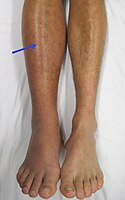
Photo from wikipedia
OBJECTIVES Acute limb ischemia (ALI) is challenging to treat due to high morbidity and mortality. Endovascular-first options beginning with thrombolysis are technically feasible with similar results to open surgery. We… Click to show full abstract
OBJECTIVES Acute limb ischemia (ALI) is challenging to treat due to high morbidity and mortality. Endovascular-first options beginning with thrombolysis are technically feasible with similar results to open surgery. We examined our experience with thrombolysis to identify patients and target conduits that are predictive of improved outcomes. METHODS We performed a retrospective review of our institutional database of thrombolysis cases for arterial lower extremity disease. Thrombolysis was the index procedure and any subsequent treatment was a reintervention. Conversion to open surgery perioperatively such as thromboembolectomy or bypass was considered a technical failure. Primary outcomes included primary patency, secondary patency, amputation free survival (AFS), and survival. Secondary outcomes included conversion to open, reintervention <30d, and amputation <30d. Descriptive statistics and analysis of variance were performed for preoperative and intraoperative risk factors. Kaplan meier estimation and cox proportional hazard models were used for primary and secondary outcomes. RESULTS Ninety-nine patients with ALI were treated with thrombolysis from 2007-2017. Thrombolysis was attempted on native artery (40%), vein bypass (7%), prosthetic bypass (33%), and stent (19%). Rutherford class distribution was 50% class I, 41% class IIa, 5% class IIb, and 3% class III. Technical success was 70%, characterized by an all-endovascular approach, patency at 30d, and AFS for 30d. Primary patency at 1- and 2- years was 31% and 22%, respectively. Secondary patency at 1- and 2- years was 39% and 27%, respectively. Overall, 30% required conversion to open surgery at the time of the index procedure, 7% reintervention <30d, 5% mortality <30d and 5% major amputation <30d. Prosthetic grafts and vein bypasses had the worst primary and secondary patency (P<0.05). Five out of 7 vein bypasses required open conversion. Thrombolysis of native arteries was most successful maintaining primary patency (P<0.05), secondary patency (P<0.05), and AFS (P<0.05). Patients who had adjunctive procedures at the time of thrombolysis had a significantly greater primary patency (P<0.05) and secondary patency (P<0.05) but not greater AFS. CONCLUSIONS Outcomes in thrombolysis for ALI have not significantly improved 20 years after the STILE trial. Technical success and mid-term patency rates are modest at best. Thrombolysis of vein bypasses and prosthetic grafts have poor technical success and primary patency compared to native arteries. However, aggressive adjunctive interventions during thrombolysis appear to improve primary and secondary patency.
Journal Title: Annals of vascular surgery
Year Published: 2020
Link to full text (if available)
Share on Social Media: Sign Up to like & get
recommendations!